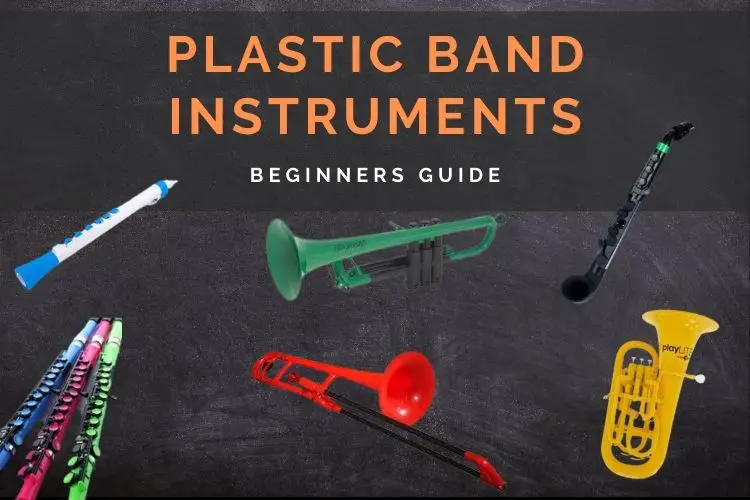Plastic band instruments are an excellent way for beginners or someone to start playing and learning music. They also can be very valuable in some circumstances for more advanced players.
And they are getting more and more popular these days, while their offer is also increasing.
These instruments are usually fairly inexpensive and aren’t anymore used only as “toys” for kids to start playing with. Recently, both their quality as well as the quantity of brands and models you can find, has been steadily increasing.
Nonetheless, there is still much doubt and misunderstanding about the use of plastic musical instruments. Additionally, information online is still scarce and makes you even more confused.
Perhaps you are not sure if it’s the proper option to start with, either for your child or even for you as a beginner.
You might ask:
- How exactly is their sound-quality?
- What are the advantages and disadvantages comparing to brass-made instruments?
- Will the band director or music teacher accept it?
- How much do they cost?
After spending many hours doing the research and testing for ourselves to check if our two kids could start being introduced to band instruments with plastic versions, we’ve made a full guide covering it, that we hope will be especially handy for beginners.
We hope it helps in deciding whether this type of instrument happens to be the right choice for you at this stage.
Should You Buy a Plastic Instrument to Start With?
The straight answer is yes, but might not be the right answer for everyone.
That will depend on different factors, namely if the player is capable of taking well care of an instrument, their level, ambitions, where they play, and how much are willing to spend.
Those are the circumstances that might influence a decision between starting with a plastic instrument or the “normal” and most common types of music instruments.
Generally, a band instrument made out of plastic can be the most recommended option if:
- it’s for a child or a toddler
- for beginner level players
- for more advanced players looking to have a secondary option instrument
- looking to try another instrument in the band
- for players that need to play outside (commonly performing in marching bands):
- in environments that can be harsh for instruments
- the player needs to carry the instruments for long periods of time

What Band Instruments Have a Version Made in Plastic?
Currently, you can find plastic versions of almost all band instruments. After the launch of the first “pBone” in 2010, in what was considered as the first recognized plastic wind instrument, manufacturers have been increasing their product lists with more alternatives made with this material.
Nowadays, the most commonly known plastic band instruments are plastic trumpets and trombones.
But, the sector has increased in terms of variety, and now, you can easily find almost all band instruments performing in a typical school band, made of plastic.
Plastic Brass Instruments
Plastic Trombones
The reality of plastic band instruments came to life on a version of a trombone, called pBone. It lowered significantly the entry costs for buying band instruments, and nowadays, you can also find plastic trombones with F-attachment.

Plastic Trumpets
Practically right after the innovation done with plastic trombones, came a version of a basic Bb plastic trumpet. And with it, the possibility of choosing a variety of colors and finishes takes the personalization of an instrument into new levels, almost only depending on your creativity and imagination.
Also important is the fact that you can use a “normal” metal mouthpiece on it, which increases the sound quality of the instrument itself. Currently, it’s a practice extended to other plastic band instruments.

Recently there have been also some plastic versions for the piccolo trumpet.

Plastic Tubas and Euphoniums
The plastic versions of tubas are lightweight alternatives and less costly.
Together with Euphoniums, it’s the type of instrument where a plastic version can be a real alternative or a secondary instrument.
They can be useful for school players considering their lightweight, as well as the benefits they can have for performing outside, especially in parade gigs.

An orange plastic tuba (Cool Wind) 
A black colored Euphonium (playLite)
Plastic Woodwind Instruments
Plastic Piccolos
Together with plastic flugelhorns, plastic piccolos are a relatively recent addition to the family of plastic instruments.
The plastic version of the similar instrument to the flute tends to get a warmer tone quality when compared to “normal” metal piccolos and ends up being a durable instrument.
That fact can be ideal for using outdoors and for younger players that might also use them indoors.
Plastic Clarinets
Perhaps the one instrument that might not be as recent and innovative in terms of the use of plastic materials or composites.
Clarinet models made from plastic or composite materials have already several years, but nowadays are being considered more and more, especially by instructors for younger kids that play the clarinet, but aren’t ready yet to use them in typical school band programs.
Their price ranges up to around $150 these days.
Plastic Flutes
If you think that plastic flutes might be only for beginners, then you might be surprised by the number of versions that are also being made targeting professional users.
Such models can be worth more than $1000 and in contrast, entry-level plastic flutes made especially for beginners are around $100 to $150.

Plastic Saxophones
Perhaps the band instrument hasn’t seen yet great innovation in terms of different materials used for its manufacturing. Around 10 years ago, a company from Thailand, decided to commercialize a Polycarbonate Alto Saxophone, called Vibrato.
For several years the Vibrato was somehow the only plastic version of a saxophone with significant commercialization until other companies have started to commercialize more options recently.
For example, Nuvo, has started to commercialize the jSAX.

There is still room to improve for quality plastic saxophones targeting students and beginner players.
Advantages and Disadvantages of Plastic Band Instruments
Advantages:
- Durability: normally pointed as the main advantage for opting for a plastic instrument. Considering, how often a child might drop such an instrument, this is a great advantage when comparing for example to brass instruments, that might be damaged easier. For adults, you might consider this option when playing outside performances, instead of bringing your other more expensive model(s)
- Lightweight: ideal for light practices and outdoor gigs. More comfortable for kids that play bigger instruments. Easier to store and to carry.
- Cheaper: they are more affordable when comparing to brand new instruments or even some used instruments. Ideal for new players starting and that aren’t sure about continuing to play a musical instrument.
- Colorful: more attractive for the younger generations with their gnarly colors. An opportunity for school bands to get creative and form a group with color-matched instruments


- Less affected by outdoor environments: they can stand harsher outside environments, namely cold outdoor temperatures or all types of weather (consider outdoor marching bands performances for example)
- Easier to take care of: the maintenance of a plastic instrument is easier and also cheaper
- Safer: considering brothers or sisters that train with their instrument at home, this could be a safer option if you are in presence of younger toddlers crawling around the house.
Disadvantages:
- Sound quality: despite not sounding as bad as you might expect, plastic isn’t as resonant as for example brass. When listening close enough, it’s possible to hear that the tone doesn’t match completely as to brass made instruments. You can get a fairly decent sound, some pointing to about 80% to 90% when compared to a brass similar instrument. If you had a metal mouthpiece, then the overall tone could get even closer.
- Difficulty to match timbre, volume, and pitch: for some types of plastic instruments and to some players, it could be more difficult to play when comparing to counterparts
- Reseller market value: brass-made instruments normally retain their values. Plastic ones won’t.
- The plastic mouthpieces they come with: you need to get a good metal mouthpiece instead of the original plastic mouthpieces. It will get you a better sound. Plastic ones can be useful only for very cold outdoor environments
- Repairing: normally if a plastic instrument breaks (for example, it snaps), it might not be fixed
- Environmental concerns regarding plastic: despite not being a single-use type of product, it’s made of plastic which draws various environmental concerns nowadays
Approval by Music Teachers and Band Directors
Despite that acceptance is changing since the first plastic instrument came to the market, there is still a normal resistance from band directors or music teachers when it comes to accepting plastic instruments in a band setup.
Normally, students might be persuaded to find brass or metal alternatives instead, if they came with a plastic instrument in the first place.
This is mainly due to the sound quality, which doesn’t match yet brass or metal alternatives. However, with developments in the sound quality of the plastic versions, such acceptance might become wider and more frequent.
Cost of Plastic Band Instruments
Plastic band instruments are significantly cheaper when comparing to the ones manufactured with brass, metal, or other types of materials. Prices will however vary depending on the brand, the quality, the level of players they’re aiming at, and the customization or personalization of the instrument itself.
| Instrument | Price Range |
| Plastic Trombones | $100 – $250 |
| Plastic Trumpet | $100 – $250 |
| Plastic Flutes | $130 – $230 |
| Plastic Clarinets | $120 – $160 |
| Plastic French Horns | $600 |
| Plastic Tubas | $1,500-$2,100 |
Some Common Asked Questions
Are these Plastic Music Instruments an Option to Start With?
The main target for plastic music instruments continues to be the younger generation that is yet to play more seriously in a school band and is still getting used to playing instruments.
Whether because of the size, the price, or how heavy they can be, “normal” band instruments are still not the most comfortable for some ages. These instruments can be perfectly helpful for such kids willing to start contacting an instrument.
Pros and Cons of Plastic Instruments
Lightweight, durability, and price are the three main factors that can be pointed as more advantageous when comparing a plastic instrument to a brass counterpart.
On the other hand, their sound quality isn’t the best yet and despite that, you should be surprised if testing a plastic instrument on how they resonate, they don’t match up 100% to common band instruments.
Which Role Will Plastic Instruments Have in the Future of Band Instruments?
Despite improving quality and having more and more models coming out each year, plastic instruments are still far from fully replacing brass-made instruments soon.
Instead, they will serve as a complementary set of instruments that could be ideal for younger generations starting in a band and to specific situations and environments, where creativity can take off while taking advantage of their gnarly colors and formats to create unique performances.

